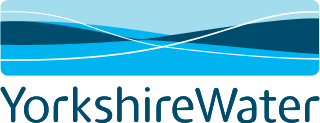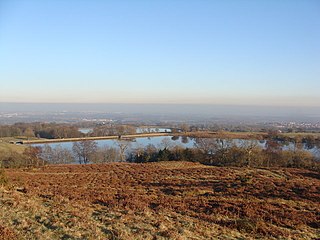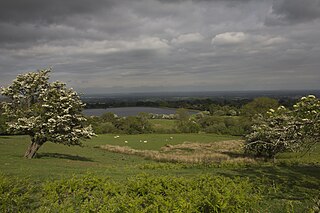
Ladybower Reservoir is a large Y-shaped, artificial reservoir, the lowest of three in the Upper Derwent Valley in Derbyshire, England. The River Ashop flows into the reservoir from the west; the River Derwent flows south, initially through Howden Reservoir, then Derwent Reservoir, and finally through Ladybower Reservoir. The reservoir is owned by Severn Trent.

Lake Vyrnwy is a reservoir in Powys, Wales, built in the 1880s for Liverpool Corporation Waterworks to supply Liverpool with fresh water. It flooded the head of the Vyrnwy valley and submerged the village of Llanwddyn.

United Utilities Group plc (UU) is the United Kingdom's largest listed water company. It was founded in 1995 as a result of the merger of North West Water and NORWEB. The group manages the regulated water and waste water network in North West England, which includes Cumbria, Greater Manchester, Lancashire, Merseyside, most of Cheshire and a small area of Derbyshire, which have a combined population of more than seven million.

Yorkshire Water is a water supply and treatment utility company servicing West Yorkshire, South Yorkshire, the East Riding of Yorkshire, part of North Lincolnshire, most of North Yorkshire and part of Derbyshire, in England. The company has its origins in the Yorkshire Water Authority, one of ten regional water authorities created by the Water Act 1973, and privatised under the terms of the Water Act 1989, when Yorkshire Water plc, the parent company of the Yorkshire Water business, was floated on the London Stock Exchange. The parent company was Kelda Group in 1999. In February 2008, Kelda Group was bought by a consortium of infrastructure funds.
Dŵr Cymru Welsh Water is a not-for-profit company which supplies drinking water and wastewater services to most of Wales and parts of western England that border Wales. In total, it serves around 1.4 million households and businesses and around three million people - and supplies nearly 830 million litres of drinking water per day.

Thames Water Utilities Ltd, known as Thames Water, is a large private utility company responsible for the water supply and waste water treatment in most of Greater London, Luton, the Thames Valley, Surrey, Gloucestershire, north Wiltshire, far west Kent, and some other parts of England; like other water companies, it has a monopoly in the regions it serves.

The Clywedog Reservoir is a reservoir near Llanidloes, Wales on the head-waters of the River Severn. The construction of the reservoir was enabled by an Act of Parliament which asserted that "At certain times the flow of water in the river is inadequate ... unless that flow were regulated so as to ensure that at those times water in addition to the natural flow will flow down the river."

Southern Water is the private utility company responsible for the public wastewater collection and treatment in Hampshire, the Isle of Wight, West Sussex, East Sussex and Kent, and for the public water supply and distribution in approximately half of this area. Some areas within the Southern Water region are supplied by a number of smaller water supply companies. Southern Water supplies an area totalling 4,450 sq. km. and serves 2.26 million customers.
Wessex Water Services Limited, known as Wessex Water, is a water supply and sewerage utility company serving an area of South West England, covering 10,000 square kilometres including Bristol, most of Dorset, Somerset and Wiltshire and parts of Gloucestershire and Hampshire. Wessex Water supplies 1.3 million people with around 285 million litres of water a day.

South Staffordshire Water plc known as South Staffs Water is a UK water supply company owned by a privately owned utilities company serving parts of Staffordshire the West Midlands as well as small areas of surrounding counties in England. South Staffordshire Water plc is part of South Staffordshire plc. It purchased Cambridge Water in 2011. In 2013, KKR & Co. L.P., a company registered in the United States of America, acquired South Staffordshire Water from Alinda Infrastructure Fund. As of April 2018, KKR & Co. has agreed to sell its 75% equity stake in South Staffordshire Water to Arjun Infrastructure Partners (AIP).

The Water Industry Act 1991 is an Act of the United Kingdom Parliament consolidating previous enactments relating to the water supply and the provision of wastewater services in England and Wales. It further implemented recommendations of the Law Commission.
Severn Trent Water Authority was one of ten regional water authorities established in 1974. Its area of operation was the catchments of the River Trent and River Severn. It assumed the powers and responsibilities of existing water supply authorities in those catchment areas, the Severn River Authority, the Trent River Authority and the sewage and sewage disposal responsibilities of the councils within its area.

Public water supply and sanitation in England and Wales has been characterised by universal access and generally good service quality. In both England and Wales, water companies became privatised in 1989, although Dwr Cymru operates as a not-for-profit organisation. Whilst independent assessments place the cost of water provision in Wales and England as higher than most major countries in the EU between 1989 and 2005, the government body responsible for water regulation, together with the water companies, have claimed improvements in service quality during that period.

The City of Nottingham Water Department (1912–1974), formerly the Nottingham Corporation Water Department (1880–1912), was responsible for the supply of water to Nottingham from 1880 to 1974. The first water supply company in the town was the Nottingham Waterworks Company, established in 1696, which took water from the River Leen, and later from springs at Scotholme, when the river became polluted. Other companies were set up in the late 18th century and in 1824, while in 1826 the Trent Water Company was established. They employed Thomas Hawksley as their engineer, who became one of the great water engineers of the period, and Nottingham had the first constant pressurised water supply system in the country. The various companies amalgamated in 1845, and Hawksley remained as the consulting engineer until 1879.
A regional water authority, commonly known as a water board, was one of a group of public bodies that came into existence in England and Wales in April 1974, as a result of the Water Act 1973 coming into force. This brought together in ten regional units a diverse range of bodies involved in water treatment and supply, sewage disposal, land drainage, river pollution and fisheries. They lasted until 1989, when the water industry was privatised and the water supply and sewerage and sewage disposal parts became companies and the regulatory arm formed the National Rivers Authority. Regional water authorities were also part of the Scottish water industry when three bodies covering the North, West and East of Scotland were created in 1996, to take over responsibilities for water supply and sewage treatment from the regional councils, but they only lasted until 2002, when they were replaced by the publicly owned Scottish Water.

Hafren Dyfrdwy Cyfyngedig is a water company providing water and wastewater treatment services, operating in north east and mid Wales. It provides water only in Wrexham and parts of Denbighshire and Flintshire and both water and wastewater in northern Powys. It previously served north east Wales and parts of North West England as Dee Valley Water until June 2018. Its parent entity, Dee Valley Group plc had shares listed on the FTSE Fledgling Index on the London Stock Exchange, but was purchased by Severn Trent in February 2017.

The Water Act 1989 is an Act of the Parliament of the United Kingdom that reorganised the bodies responsible for all aspects of water within England and Wales. Whereas previous legislation, particularly the Water Act 1973, had focused on providing a single unifying body with responsibility for all water-related functions within a river basin or series of river basins, this legislation divided those functions up again, with water supply, sewerage and sewage disposal being controlled by private companies, and the river management, land drainage and pollution functions becoming the responsibility of the National Rivers Authority.
There are a large number of reservoirs in Wales reflecting the need for the supply of water for both industry and for consumption, both within the country itself and in neighbouring England. A number also provide hydroelectricity and many old reservoirs also provided motive power for industries, especially for the processing of minerals such as metal ores and slate.

Cae Llwyd is a reservoir located between Llwyneinion and the Ruabon Moors in Wrexham County Borough, Wales.

Ty Mawr is a reservoir located between Llwyneinion and the Ruabon Moors in Wrexham County Borough, Wales. It is next to Cae Llwyd Reservoir.















